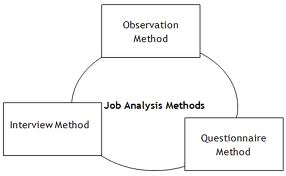Certify and Increase Opportunity.
Be
Govt. Certified HR Staffing Manager
HR Staffing | Methods of Job analysis
Job analysis information can be gathered in a variety of ways. One consideration is who is to conduct the job analysis. Most frequently, a member of the HR staff coordinates this effort. Depending on which of the methods discussed next is used, others who often participate are managers, supervisors, and employees doing the jobs. For more complex analyses, industrial engineers may conduct time and motion studies.
Another consideration is the method to be used. Common methods are observations, interviews, questionnaires, and specialized methods of analysis. Combinations of these approaches frequently are used, depending on the situation and the organization. Each of these methods is discussed in some detail next.
Common methods of job analysis include the following:
Observation: A trained observer observes a worker, recording what the worker does, how the work is done, and how long it takes. There are two types of observation: (1)Continuous observation involves observing a job over a given period of time. (2)Sampling involves observing several incumbents over random, relatively short periods of time. Observation is a simple and frequently used method of job analysis
Interview: A trained job analyst interviews a job incumbent, usually utilizing a standardized format. Sometimes more than one worker is interviewed, and the results are aggregated. Another variation is the group interview, where several incumbents are interviewed at the same time.
Critical Incident: Behaviorally based critical incidents are used to describe work, and a job analyst determines the degree of each behavior that is present or absent in the job.
Diary: The job incumbent records activities and tasks in a log as they are performed.
Checklist: A worker or supervisor check items on a standardized task inventory that apply to the job. Checklists may be custom-made or purchased from an outside vendor.
Questionnaire:There are two types of questionnaires: The structured questionnaire uses a standardized list of work activities, called a task inventory, that job incumbents or supervisors may identify as related to the job. In addition, the respondent may also identify additional information such as how much time is spent on the task, the amount of supervision required, and/or the expertise required. The open-ended questionnaire asks the job incumbent to describe the work in his or her own words.
Technical Conference: Several experts (often called “subject matter experts”) on the job collaborate to provide information about the work performed. A job analyst facilitates the process and prepares the job description based on the consensus of the technical experts.
Apply for HR Staffing Certification Now!!
http://www.vskills.in/certification/Certified-HR-staffing-manager


